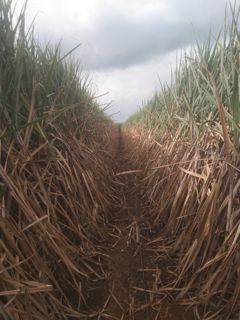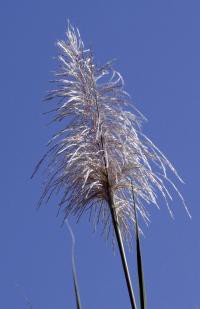
Sugarcane originated in Papua New Guinea. It belongs to the Graminaceae family and to the botanical genus Saccharum, which comprises three sugar-bearing species―S. officinarum, known as "noble cane", S. sinense, and S. barberi ―and three non-sugar-bearing species―S. robustum, S. spontaneum and S. edule. In the 1880s, agronomists began creating hybrids between noble cane and the other species. The modern varieties are all derived from those crosses.
A sugarcane plant is a tuft of between 5 and 20 upright stems, or "tillers", 2 to 5 metres tall and 2 to 4 centimetres in diameter. Each stem is a succession of nodes and internodes; each node bears a bud and a band of root primordia. The sugar is stored in the pith, under the hard, waxy bark. Cuttings a few nodes long are taken from the stems and used to replant cane fields every five to ten years. The stems are also very rich in cellulose and lignin, which have many uses in the green chemicals industry and as fuels, energy, materials, etc.
 République française. Liberté Egalité Fraternité
République française. Liberté Egalité Fraternité
Cirad, la recherche agronomique pour le développement durable des régions tropicales et méditerranéennes
Search on site
Clear search
Sugarcane value chain © R. Carayol
Sugarcane
Sugarcane is grown in more than a hundred countries, by independent farmers and agroindustrial firms. While the sugar and rum markets have always been the prime outlets for the crop, it is increasingly the object of interest from pharmaceutical, chemical and energy firms. Farmers will have to satisfy growing, ever more diverse demand. CIRAD and its partners are therefore helping sugarcane value chains evolve and diversify.
Context and issues
What CIRAD is doing
Plant and uses
Resources
Summary
Sugarcane, a giant grass full of sugar
In the sugarcane fields
A highly coveted plant
From cane to sugar
Making rum
Bagasse, molasses, ethanol…
Sugarcane value chain illustration © Delphine Guard-Lavastre, CIRAD
Sugarcane is a giant tropical grass from the family Graminaceae, whose stalk has the particular capacity to store a crystallizable sugar, sucrose. Its main use is in industrial processing of the stalks to make rum. However, the impressive plant mass it produces can also be converted into energy—combustible material, charcoal or biofuel—and also contains a wealth of molecules for the chemicals industry.
Sugarcane, a giant grass full of sugar
Canne à sucre © Cirad
Sugarcane originated in Papua New Guinea. It belongs to the Graminaceae family and to the botanical genus Saccharum, which comprises three sugar-bearing species―S. officinarum, known as "noble cane", S. sinense, and S. barberi ―and three non-sugar-bearing species―S. robustum, S. spontaneum and S. edule. In the 1880s, agronomists began creating hybrids between noble cane and the other species. The modern varieties are all derived from those crosses.
A sugarcane plant is a tuft of between 5 and 20 upright stems, or "tillers", 2 to 5 metres tall and 2 to 4 centimetres in diameter. Each stem is a succession of nodes and internodes; each node bears a bud and a band of root primordia. The sugar is stored in the pith, under the hard, waxy bark. Cuttings a few nodes long are taken from the stems and used to replant cane fields every five to ten years. The stems are also very rich in cellulose and lignin, which have many uses in the green chemicals industry and as fuels, energy, materials, etc.
The plants bear many long, narrow leaves. Through photosynthesis, this large leaf area serves to produce plant matter, of which the main molecule is sugar. The leaves are also good fodder for livestock.
The root system is both dense and deep. This is why sugarcane protects soils efficiently, notably against erosion due to heavy rains and cyclones.
The inflorescence, or spike, is a panicle comprising a multitude of flowers that produce tiny seeds, known as "fuzz".
Like maize and sorghum, sugarcane is a "C4" plant. Their specific functioning enables them to absorb much more carbon dioxide (CO2) and sunlight than other plants. In exchange, they also give off more oxygen and produce substantial amounts of biomass. In sugarcane, this hyperactivity results in luxuriant vegetation and high sugar content.
0 件のコメント
この投稿にコメントしよう!
この投稿にはまだコメントがありません。
ぜひあなたの声を聞かせてください。
